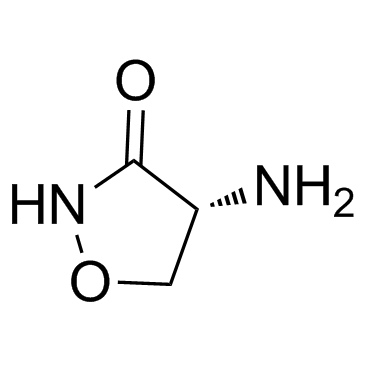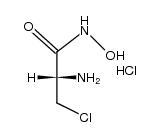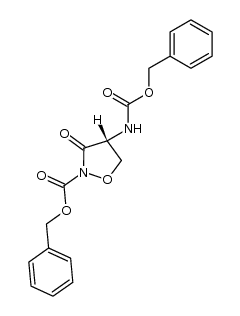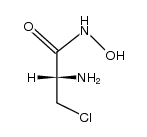CHEMICAL IDENTIFICATION
-
RTECS NUMBER :
-
NY2975000
-
CHEMICAL NAME :
-
3-Isoxazolidinone, 4-amino-, D-
-
CAS REGISTRY NUMBER :
-
68-41-7
-
BEILSTEIN REFERENCE NO. :
-
0080798
-
LAST UPDATED :
-
199612
-
DATA ITEMS CITED :
-
20
-
MOLECULAR FORMULA :
-
C3-H6-N2-O2
-
MOLECULAR WEIGHT :
-
102.11
-
WISWESSER LINE NOTATION :
-
T5OMVTJ DZ -D
HEALTH HAZARD DATA
ACUTE TOXICITY DATA
-
TYPE OF TEST :
-
TDLo - Lowest published toxic dose
-
ROUTE OF EXPOSURE :
-
Oral
-
SPECIES OBSERVED :
-
Human
-
DOSE/DURATION :
-
560 mg/kg/4W-I
-
TOXIC EFFECTS :
-
Behavioral - wakefulness Behavioral - tremor
-
REFERENCE :
-
DICHAK Diseases of the Chest. (Chicago, IL) V.1-56, 1935-69. For publisher information, see CHETBF. Volume(issue)/page/year: 29,241,1956
-
TYPE OF TEST :
-
TDLo - Lowest published toxic dose
-
ROUTE OF EXPOSURE :
-
Oral
-
SPECIES OBSERVED :
-
Human - woman
-
DOSE/DURATION :
-
60 mg/kg
-
TOXIC EFFECTS :
-
Behavioral - coma
-
REFERENCE :
-
BMJOAE British Medical Journal. (British Medical Assoc., BMA House, Tavistock Sq., London WC1H 9JR, UK) V.1- 1857- Volume(issue)/page/year: 1,907,1965
-
TYPE OF TEST :
-
TDLo - Lowest published toxic dose
-
ROUTE OF EXPOSURE :
-
Unreported
-
SPECIES OBSERVED :
-
Human - woman
-
DOSE/DURATION :
-
40 mg/kg/2D-I
-
TOXIC EFFECTS :
-
Behavioral - hallucinations, distorted perceptions
-
REFERENCE :
-
TUBEAS Tubercle. (Williams & Wilkins Co., 428 E. Preston Street, Baltimore, MD 21202) V.1- 1919- Volume(issue)/page/year: 38,297,1957
-
TYPE OF TEST :
-
TDLo - Lowest published toxic dose
-
ROUTE OF EXPOSURE :
-
Unreported
-
SPECIES OBSERVED :
-
Human - man
-
DOSE/DURATION :
-
64 mg/kg/4D-I
-
TOXIC EFFECTS :
-
Behavioral - sleep Behavioral - altered sleep time (including change in righting reflex) Behavioral - convulsions or effect on seizure threshold
-
REFERENCE :
-
ABANAE Antibiotics Annual. (New York, NY) 1953-60. For publisher information, see AMACCQ. Volume(issue)/page/year: 3,148,1955/1956
-
TYPE OF TEST :
-
LD50 - Lethal dose, 50 percent kill
-
ROUTE OF EXPOSURE :
-
Oral
-
SPECIES OBSERVED :
-
Rodent - rat
-
DOSE/DURATION :
-
>5 gm/kg
-
TOXIC EFFECTS :
-
Behavioral - somnolence (general depressed activity)
-
REFERENCE :
-
ANTCAO Antibiotics and Chemotherapy (Washington, DC). (Washington, DC) V.1-12, 1951-62. For publisher information, see CLMEA3. Volume(issue)/page/year: 6,360,1956
-
TYPE OF TEST :
-
LD50 - Lethal dose, 50 percent kill
-
ROUTE OF EXPOSURE :
-
Subcutaneous
-
SPECIES OBSERVED :
-
Rodent - rat
-
DOSE/DURATION :
-
>3 gm/kg
-
TOXIC EFFECTS :
-
Behavioral - somnolence (general depressed activity)
-
REFERENCE :
-
ANTCAO Antibiotics and Chemotherapy (Washington, DC). (Washington, DC) V.1-12, 1951-62. For publisher information, see CLMEA3. Volume(issue)/page/year: 6,360,1956
-
TYPE OF TEST :
-
LD50 - Lethal dose, 50 percent kill
-
ROUTE OF EXPOSURE :
-
Oral
-
SPECIES OBSERVED :
-
Rodent - mouse
-
DOSE/DURATION :
-
5290 mg/kg
-
TOXIC EFFECTS :
-
Behavioral - somnolence (general depressed activity) Behavioral - ataxia
-
REFERENCE :
-
ANTCAO Antibiotics and Chemotherapy (Washington, DC). (Washington, DC) V.1-12, 1951-62. For publisher information, see CLMEA3. Volume(issue)/page/year: 6,360,1956
-
TYPE OF TEST :
-
LD50 - Lethal dose, 50 percent kill
-
ROUTE OF EXPOSURE :
-
Intraperitoneal
-
SPECIES OBSERVED :
-
Rodent - mouse
-
DOSE/DURATION :
-
180 mg/kg
-
TOXIC EFFECTS :
-
Details of toxic effects not reported other than lethal dose value
-
REFERENCE :
-
85FZAT "Index of Antibiotics from Actinomycetes," Umezawa, H. et al., eds., Tokyo, Univ. of Tokyo Press, 1967 Volume(issue)/page/year: -,238,1967
-
TYPE OF TEST :
-
LD50 - Lethal dose, 50 percent kill
-
ROUTE OF EXPOSURE :
-
Subcutaneous
-
SPECIES OBSERVED :
-
Rodent - mouse
-
DOSE/DURATION :
-
1400 mg/kg
-
TOXIC EFFECTS :
-
Details of toxic effects not reported other than lethal dose value
-
REFERENCE :
-
YKYUA6 Yakkyoku. Pharmacy. (Nanzando, 4-1-11, Yushima, Bunkyo-ku, Tokyo, Japan) V.1- 1950- Volume(issue)/page/year: 31,1085,1980
-
TYPE OF TEST :
-
LD50 - Lethal dose, 50 percent kill
-
ROUTE OF EXPOSURE :
-
Intravenous
-
SPECIES OBSERVED :
-
Rodent - mouse
-
DOSE/DURATION :
-
560 mg/kg
-
TOXIC EFFECTS :
-
Details of toxic effects not reported other than lethal dose value
-
REFERENCE :
-
YKYUA6 Yakkyoku. Pharmacy. (Nanzando, 4-1-11, Yushima, Bunkyo-ku, Tokyo, Japan) V.1- 1950- Volume(issue)/page/year: 31,1085,1980
-
TYPE OF TEST :
-
LD50 - Lethal dose, 50 percent kill
-
ROUTE OF EXPOSURE :
-
Oral
-
SPECIES OBSERVED :
-
Mammal - dog
-
DOSE/DURATION :
-
>2 gm/kg
-
TOXIC EFFECTS :
-
Gastrointestinal - nausea or vomiting
-
REFERENCE :
-
ANTCAO Antibiotics and Chemotherapy (Washington, DC). (Washington, DC) V.1-12, 1951-62. For publisher information, see CLMEA3. Volume(issue)/page/year: 6,360,1956
-
TYPE OF TEST :
-
LDLo - Lowest published lethal dose
-
ROUTE OF EXPOSURE :
-
Subcutaneous
-
SPECIES OBSERVED :
-
Mammal - dog
-
DOSE/DURATION :
-
2 gm/kg
-
TOXIC EFFECTS :
-
Behavioral - somnolence (general depressed activity) Behavioral - tremor Gastrointestinal - nausea or vomiting
-
REFERENCE :
-
ANTCAO Antibiotics and Chemotherapy (Washington, DC). (Washington, DC) V.1-12, 1951-62. For publisher information, see CLMEA3. Volume(issue)/page/year: 6,708,1956
-
TYPE OF TEST :
-
LDLo - Lowest published lethal dose
-
ROUTE OF EXPOSURE :
-
Subcutaneous
-
SPECIES OBSERVED :
-
Primate - monkey
-
DOSE/DURATION :
-
4 gm/kg
-
TOXIC EFFECTS :
-
Behavioral - somnolence (general depressed activity) Behavioral - ataxia Gastrointestinal - nausea or vomiting
-
REFERENCE :
-
ANTCAO Antibiotics and Chemotherapy (Washington, DC). (Washington, DC) V.1-12, 1951-62. For publisher information, see CLMEA3. Volume(issue)/page/year: 6,708,1956
-
TYPE OF TEST :
-
LD - Lethal dose
-
ROUTE OF EXPOSURE :
-
Oral
-
SPECIES OBSERVED :
-
Rodent - rabbit
-
DOSE/DURATION :
-
>2 gm/kg
-
TOXIC EFFECTS :
-
Details of toxic effects not reported other than lethal dose value
-
REFERENCE :
-
ANTCAO Antibiotics and Chemotherapy (Washington, DC). (Washington, DC) V.1-12, 1951-62. For publisher information, see CLMEA3. Volume(issue)/page/year: 6,382,1956
-
TYPE OF TEST :
-
LD50 - Lethal dose, 50 percent kill
-
ROUTE OF EXPOSURE :
-
Oral
-
SPECIES OBSERVED :
-
Rodent - guinea pig
-
DOSE/DURATION :
-
>2 gm/kg
-
TOXIC EFFECTS :
-
Details of toxic effects not reported other than lethal dose value
-
REFERENCE :
-
ANTCAO Antibiotics and Chemotherapy (Washington, DC). (Washington, DC) V.1-12, 1951-62. For publisher information, see CLMEA3. Volume(issue)/page/year: 6,360,1956
-
TYPE OF TEST :
-
LD50 - Lethal dose, 50 percent kill
-
ROUTE OF EXPOSURE :
-
Subcutaneous
-
SPECIES OBSERVED :
-
Rodent - guinea pig
-
DOSE/DURATION :
-
>1 gm/kg
-
TOXIC EFFECTS :
-
Details of toxic effects not reported other than lethal dose value
-
REFERENCE :
-
ANTCAO Antibiotics and Chemotherapy (Washington, DC). (Washington, DC) V.1-12, 1951-62. For publisher information, see CLMEA3. Volume(issue)/page/year: 6,360,1956 ** OTHER MULTIPLE DOSE TOXICITY DATA **
-
TYPE OF TEST :
-
TDLo - Lowest published toxic dose
-
ROUTE OF EXPOSURE :
-
Subcutaneous
-
SPECIES OBSERVED :
-
Mammal - dog
-
DOSE/DURATION :
-
15 gm/kg/60D-I
-
TOXIC EFFECTS :
-
Blood - pigmented or nucleated red blood cells Blood - changes in erythrocyte (RBC) count Related to Chronic Data - death
-
REFERENCE :
-
ANTCAO Antibiotics and Chemotherapy (Washington, DC). (Washington, DC) V.1-12, 1951-62. For publisher information, see CLMEA3. Volume(issue)/page/year: 6,708,1956
-
TYPE OF TEST :
-
TDLo - Lowest published toxic dose
-
ROUTE OF EXPOSURE :
-
Oral
-
SPECIES OBSERVED :
-
Primate - monkey
-
DOSE/DURATION :
-
45 gm/kg/90D-I
-
TOXIC EFFECTS :
-
Gastrointestinal - hypermotility, diarrhea Blood - changes in bone marrow (not otherwise specified) Related to Chronic Data - death
-
REFERENCE :
-
ANTCAO Antibiotics and Chemotherapy (Washington, DC). (Washington, DC) V.1-12, 1951-62. For publisher information, see CLMEA3. Volume(issue)/page/year: 6,708,1956 *** NIOSH STANDARDS DEVELOPMENT AND SURVEILLANCE DATA *** NIOSH OCCUPATIONAL EXPOSURE SURVEY DATA : NOES - National Occupational Exposure Survey (1983) NOES Hazard Code - X5527 No. of Facilities: 31 (estimated) No. of Industries: 1 No. of Occupations: 2 No. of Employees: 756 (estimated) No. of Female Employees: 559 (estimated)
|











